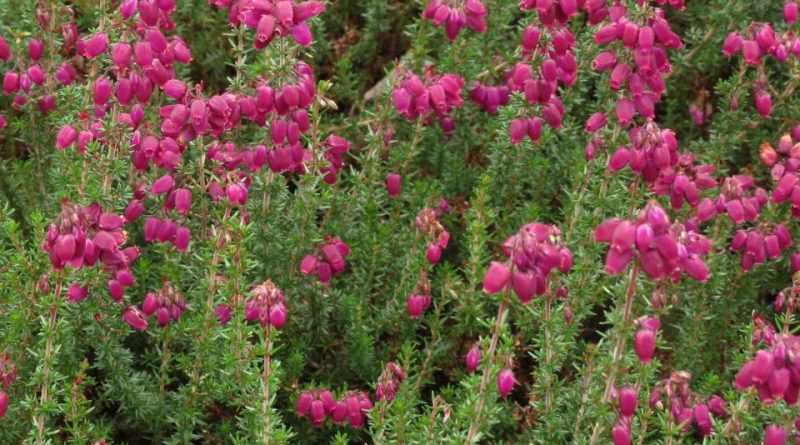Erica cinerea
Erica cinerea
The Bell heather (Erica cinerea L.) is a small shrub species belonging to the Ericaceae family.
Systematics –
From a systematic point of view it belongs to:
Eukaryota Domain,
Kingdom Plantae,
Subarign Tracheobionta,
Spermatophyta superdivision,
Division Magnoliophyta,
Class Magnoliopsida,
Subclass Dilleniidae,
Order Ericales,
Ericaceae family,
Subfamily Ericoideae,
Tribea Ericeae,
Genus Erica,
E. cinerea species.
Etymology –
The term Erica comes from the Greek ἐρείκω ereíko mince, crumble: for the habitat of debris.
The specific ashy epithet comes from cinis, cineris cenere: for the ashy, ashy, greyish color.
Geographic Distribution and Habitat –
Erica cinerea is a plant native to western and central Europe.
We find it with greater presence in Britain and Ireland, France, northern Spain and southern Norway. However, it is also present in the Faroe Islands, Belgium, Germany, northwestern Italy and the Netherlands.
Its habitat is that of moors and with relatively dry, acidic and nutrient-poor soils. It is found in the moorland of the coastal dunes and in the dune strips and occasionally in the woods.
Description –
Bell heather is a shrub with limited development that grows between 15 and 60 cm in height.
The leaves are thin and aghaiform with a length of 4-8 mm and arranged in spirals of three. The flowers have bell shaped, purple (rarely white) form, 4-7 mm long.
The antesis is between mid and late summer. The flowers have a dry texture.
Cultivation –
Inside the Bell heather, there are many cultivars with flower colors that vary considerably from white to almost black.
For its cultivation, acid soils are preferred, with sandy or medium-textured texture but limestone-free.
Even if it tolerates drought well and grows well in full sun, it is good to cultivate the plant with some winter protection in cold climates, even if they usually recover from winter damage with a decisive pruning to be done in spring.
It is a dry-sensitive plant that can dry out the foliage, which is why it should be planted in a protected place.
Another important factor for its cultivation is the drainage of the soil that must be well done and maintained.
Customs and Traditions –
The Bell heather, like other plants of the same genus, contains small amounts of hydroquinone glycosides, insufficient to carry out the disinfectant action of the urinary tract potentially useful in the presence of cystitis and urethritis. Other medicinal plants are now used in therapy for this purpose, the use of which is now standardized.
Due to the important content of tannins, heather exhibits astringent properties useful in the presence of diarrhea, while for external use it can attenuate skin inflammation (compresses) and oral mucosa (rinses).
However, several properties are attributed to it. These include diuretic, cholagogue, antirheumatic, and antibacterial activity. Furthermore, it is believed that the plant – when used externally – is also able to promote wound healing.
However, there are currently no studies available to confirm the above-mentioned properties traditionally ascribed to heather.
From an ecological standpoint, it is a plant that is an excellent source of honey; it provides a large amount of nectar for pollinators. It was ranked in the top 5 for most nectar production (nectar per unit of cover per year) in a UK plant survey conducted by the AgriLand project, supported by the UK Insect Pollinators Initiative.
The plant is grown, mostly, for ornamental purposes using multiple cultivars to obtain a wide range of colors of the blooms.
As for its presence in ecosystems, it is described as “least concern” in the IUCN Red List of threatened species.
Preparation method –
Although Erica cinerea is not among the plants used for medicinal purposes, it is still used in herbal teas for the treatment of inflammation of the urinary tract, cystitis, urethritis and uratic lithiasis (a use which has not, however, been officially approved).
Guido Bissanti
Sources
– Acta Plantarum – Flora of the Italian Regions.
– Wikipedia, the free encyclopedia.
– Useful Tropical Plants Database.
– Conti F., Abbate G., Alessandrini A., Blasi C. (ed.), 2005. An annotated checklist of the Italian vascular flora, Palombi Editore.
– Pignatti S., 1982. Flora d’Italia, Edagricole, Bologna.
– Treben M., 2000. La Salute from Farmacia del Lord, Advice and experiences with medicinal herbs, Ennsthaler Editore.
Warning: Pharmaceutical applications and alimurgical uses are indicated for informational purposes only, they do not represent in any way a medical prescription; therefore no responsibility is taken for their use for curative, aesthetic or food purposes.


